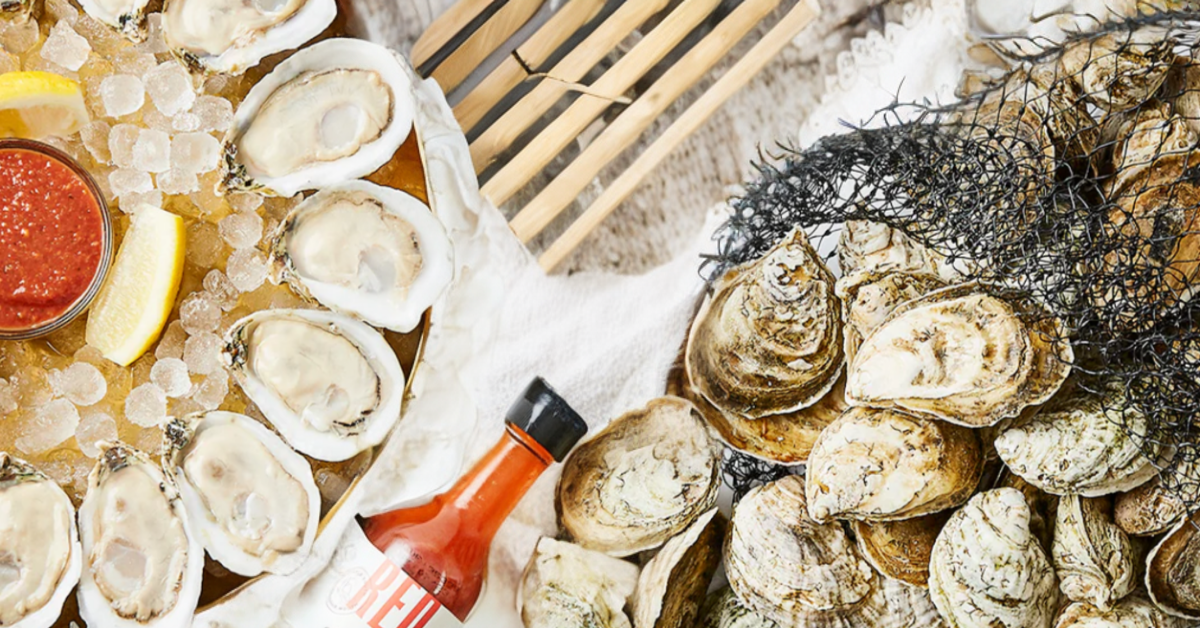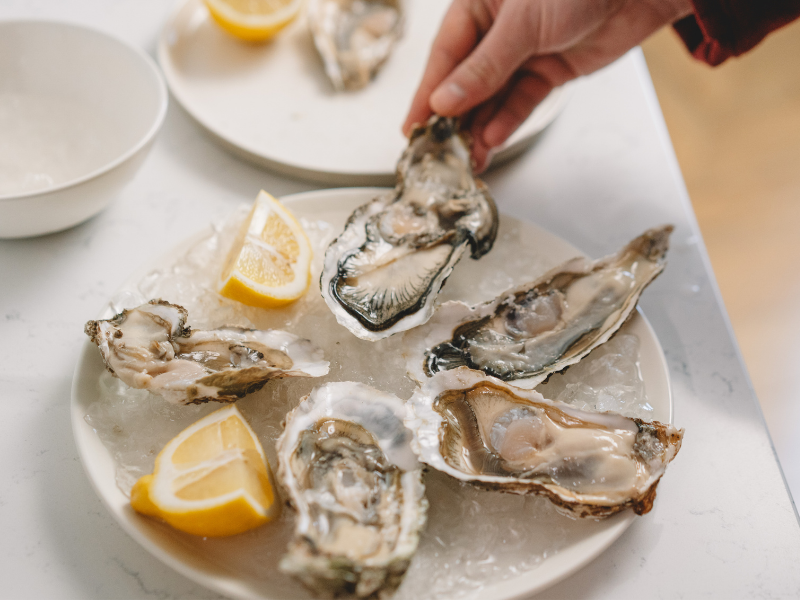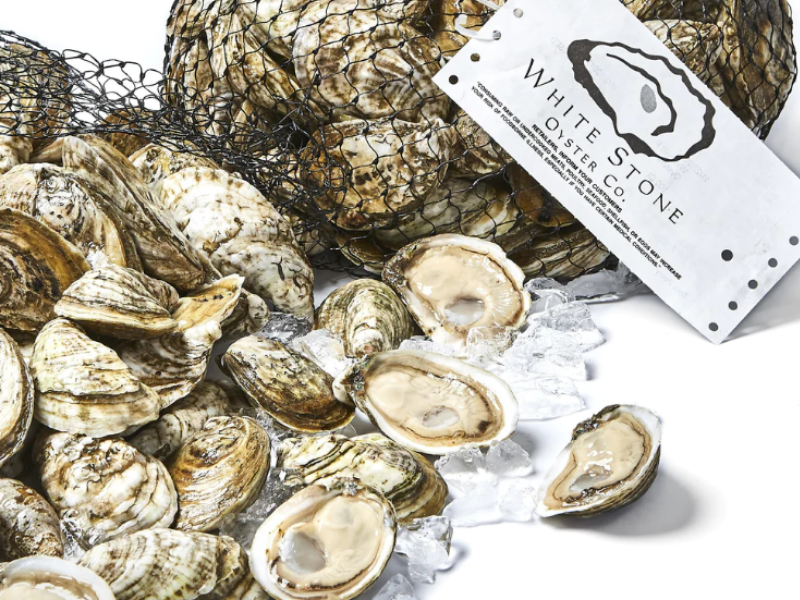
Oysters are a beloved delicacy, treasured for their briny taste and meaty texture.
But which type of oyster is best?
The Chesapeake Bay's own Bay Blue oysters stand out from the crowd.
In this post, we'll explore what makes Bay Blues so special compared to other popular oyster varieties!
What are Bay Blue Oysters?

Bay Blue oysters hail from Virginia's Chesapeake Bay. They are a larger oyster known for their mild, sweet taste. Their shells have a distinctive bluish tint on the inside, hence the name. Bay Blues are sustainably farmed right in the Chesapeake using innovative aquaculture methods. This allows their merroir - the unique taste imparted by their maritime environment - to really shine through.
Lovers of oysters everywhere seek out Bay Blues for their one-of-a-kind flavor profile.
Different Types of Oysters: A Brief Overview
The oyster world is rich in diversity. Let's briefly cover a few of the major varieties found here on the East Coast and how they compare to our beloved Bay Blues.
Rappahannock Oysters
Rappahannock oysters also hail from the Chesapeake Bay, but they have a distinctly different taste from Bay Blues. Rappahannocks are smaller, with a more intense brininess and metallic finish. They grow naturally on oyster beds near the Rappahannock River.
Chesapeake Oysters
Like Bay Blues, Chesapeake oysters come from Virginia's portion of the Chesapeake Bay. But instead of blue shells, their shells have a distinctive teal interior. Chesapeake oysters also tend to be smaller and saltier than Bay Blues.
How Does Bay Blue Compare to Other Oyster Varieties?
Flavor Profiles: Bay Blue vs. Other Oysters
Bay Blue oysters stand out from other varieties due to their distinctively mild, sweet taste. While other oysters tend to be smaller and saltier, with strong briny or metallic flavors, Bay Blues offer a more mellow sweetness. Their merroir shines through thanks to the sustainable aquaculture methods used by farms like White Stone Oysters. Lovers of oysters seek out the one-of-a-kind flavor profile of the larger, sweeter Bay Blues.
Sustainability: Bay Blue vs. Other Oysters
As filter feeders, all oysters help clean the water and benefit their environment. However, the innovative farming techniques used for Bay Blue oysters make them exceptionally sustainable. Keeping the oysters in constant motion and using floating cages allows underwater grasses and natural oyster reefs to flourish. And because Bay Blues are farmed rather than dredged, the harvest is much gentler on the seabed ecosystem. Bay Blue aquaculture has a uniquely positive impact on the Chesapeake Bay.
The Impact of Oyster Farming on the Chesapeake Bay
The Chesapeake Bay has benefited greatly from the rise of sustainable oyster farming. As filter feeders, oysters help filter algae and pollutants from the water, improving clarity and quality. Oyster farming also restores natural oyster reef habitats. Floating cultivation methods allow grasses to grow undisturbed underwater. The presence of oyster farms has led to increased environmental monitoring and awareness. Overall, the growth of oyster aquaculture has had a major positive impact on the health of the Chesapeake Bay ecosystem.
White Stone Oysters: A Trusted Source for Bay Blue

White Stone Oysters is one of the premier oyster farms supplying true Bay Blue oysters. Using an innovative cultivation method, we raise oysters near the Rappahannock River in floating cages that tumble the growing oysters for the best results. The team at White Stone Oysters is committed to sustainability, shipping fresh oysters from farm to table on the same day.
With our dedication to quality and environmental stewardship, we are a trusted source of delicious, sustainable Bay Blue oysters.
Frequently Asked Questions
What makes Bay Blue unique among oyster varieties?
Bay Blue oysters stand out from other varieties for their distinctively large size, mild sweet taste, and beautiful bluish shell interiors. Their one-of-a-kind flavor profile comes through thanks to the sustainable aquaculture practices used to raise them, allowing their merroir to shine. Lovers of high-quality oysters everywhere seek out Bay Blues specifically for their mellow brininess and signature sweetness.
How does the farming process affect the taste of Bay Blue?
The innovative farming techniques used for Bay Blue oysters are key to their exceptional flavor. Keeping the oysters tumbling at the water's surface allows for optimal food density and water flow. This constant motion enhances the oysters' sweetness. The floating cages also enable the ideal merroir to develop. Overall, the sustainable aquaculture methods result in a sweeter, milder oyster that highlights the merroir of the Chesapeake Bay.
What are the environmental benefits of oyster farming?
Oyster farming offers many environmental benefits. As filter feeders, farmed oysters help filter algae and pollutants from the water. Oyster reef restoration also occurs. Floating cultivation methods allow underwater grasses to grow undisturbed. Overall, oyster aquaculture has a positive impact on water quality, habitats, biodiversity, and ecological awareness in the Chesapeake Bay.
Concluding Thoughts on Bay Blue Oysters
Bay Blue oysters are a special variety treasured by oyster aficionados.
Their one-of-a-kind flavor and sustainable farming methods set them apart. Lovers of oysters should add Bay Blues to their bucket list to experience their signature brininess and sweetness. The growth of oyster farming continues to benefit the fragile Chesapeake Bay ecosystem. For those who enjoy oysters, Bay Blues are a must-try varietal.
← Older post Newer post →
